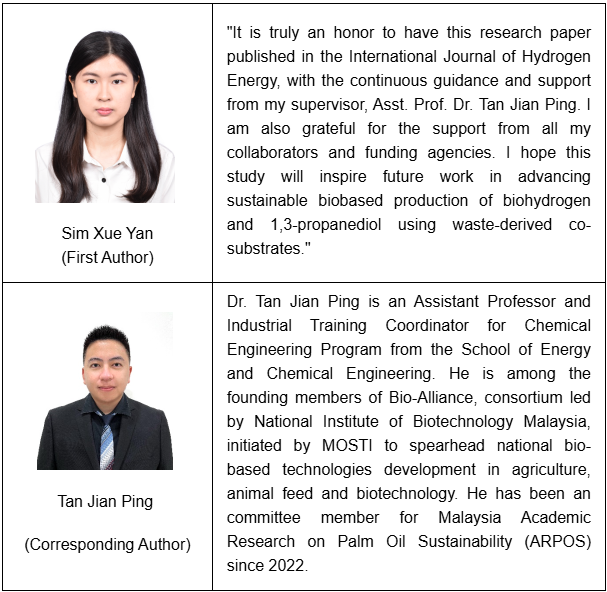Dr. Tan Jian Ping & Team Publish in International Journal of Hydrogen Energy
The Research and Postgraduate Centre congratulates Sim Xue Yan and Asst. Prof. Dr. Tan Jian Ping from the School of Energy and Chemical Engineering for their recent publication in International Journal of Hydrogen Energy, a SCI Q1 journal with an impact factor of 8.1.
This research was conducted in collaboration with Dr. Yeap Swee Keong and Dr. Hui Yew Woh from the China-ASEAN College of Marine Sciences, Xiamen University Malaysia, as well as Dr. Mong Guo Ren, Dr. Woon Kok Sin, and Dr. Tan Peng Chee from the School of Energy and Chemical Engineering.
In line with United Nations Sustainable Development Goal 7 - Affordable and Clean Energy, the study, “Synergistic impact of co-substrate of biodiesel crude glycerol and durian peel hydrolysate for biohydrogen and 1,3-propanediol synthesis by Clostridium butyricum”, explored the potential of using waste materials such as biodiesel crude glycerol and durian peel hydrolysate as co-substrates for biohydrogen and 1,3-propanediol production via dark fermentation. Introducing a sugar-based pathway in glycerol fermentation could provide extra energy for the production of biohydrogen, 1,3-propanediol, or both. Specifically, this research aimed to elucidate the impact of co-substrate ratio of glucose and glycerol on the co-production of 1,3-PDO and biohydrogen via Clostridium butyricum JKT37. The study also evaluated the performance of substituting pure glucose with durian peel hydrolysate and pure glycerol with treated palm-based glycerol in the co-fermentation process.
The findings revealed a 2.7-fold enhancement in both hydrogen yield and productivity when glucose and glycerol were co-utilized. In addition, this study showed successful replacement of glucose and glycerol with durian peel hydrolysate and treated glycerol, particularly in the hydrogen production.
The project partnered with Novozymes, a Denmark-listed company renowned as a global leader in enzyme production, featuring their latest enzyme, Cellic CTec3, as a key component of the study. Additionally, the research saw participation from the National University of Malaysia, University Putra Malaysia, Universiti Teknologi MARA (UiTM), and Xiamen University China.
In terms of financial support, this research was supported by the Ministry of Higher Education Malaysia, Malaysia, through the Fundamental Research Grant Scheme (FRGS) [project number “FRGS/1/2020/TK0/XMU/03/2”]; the Ministry of Science, Technology and Innovation (MOSTI), Malaysia [project number “TDF07211418”]; and Xiamen University Malaysia Research Fund (XMUMRF) under Xiamen University Malaysia, Malaysia [project number “XMUMRF/2022-C10/ IENG/0047”]. Additional funding was provided by Universiti Teknologi MARA (UiTM) through the Geran Penyelidikan MyRA Lepasan PhD (LPHD) grant (600-RMC/GPM LPHD 5/3 (074/2022)), allocated for the project “Co-production of Ethanol and Xylitol using Aerobic and Sequential Anaerobic Fermentation of Palm Kernel Cake Hydrolysate as Novel Substrate.”

This article can be found at https://doi.org/10.1016/j.ijhydene.2024.11.236

